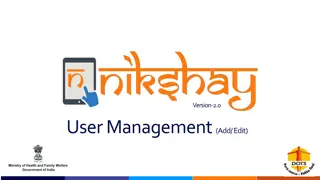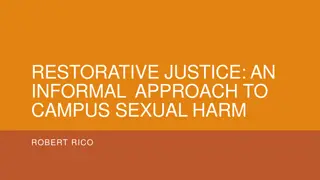Unveiling Historical Injustices: 10,000 Cries for Justice Conference
The 13th International Conference on Interdisciplinary Social Sciences at the University of Granada delves into the troubled history of WWII atrocities, focusing on Japan's unacknowledged crimes against humanity. From the horrors of vivisection on American POWs to the non-prosecution of Unit 731 leaders, this initiative seeks to shed light on past injustices and pursue accountability.
Download Presentation

Please find below an Image/Link to download the presentation.
The content on the website is provided AS IS for your information and personal use only. It may not be sold, licensed, or shared on other websites without obtaining consent from the author.If you encounter any issues during the download, it is possible that the publisher has removed the file from their server.
You are allowed to download the files provided on this website for personal or commercial use, subject to the condition that they are used lawfully. All files are the property of their respective owners.
The content on the website is provided AS IS for your information and personal use only. It may not be sold, licensed, or shared on other websites without obtaining consent from the author.
E N D
Presentation Transcript
logo 10,000 Cries for Justice 13thInternational Conference on Interdisciplinary Social Sciences University of Granada, Granada, Spain Don M. Tow President: NJ-ALPHA Co-Founder & VP: 10,000 Cries for Justice July 25, 2018
Outline Historical Background Seeking Justice: A New Initiative Digital Archive Project 10000 Cries for Justice Website New Educational Tool dmt-7/25/2018 2
Historical Background During WWII, the Japanese military committed many atrocities in many countries in Asia Comfort women (or Sex slaves) Biological and chemical weapons of mass destruction, including vivisection of Chinese civilians and American POWs Nanking Massacre Slave labor Many of the perpetuators were never prosecuted, including none of the leaders of Unit 731 When China and Japan normalized their relation on 9/29/1972, China, as a gesture of good will, renounced its demand for war preparations from Japan Although there is extensive evidence and 70+ years have elapsed since WWII ended, the Japanese government still has not admitted and apologized for these atrocities, often claiming that these atrocities were fabricated dmt-7/25/2018 3
Vivisection of American POWs Japanese Medical School Museum Exhibits Vivisection Display on American POWs: (The Japan Time News, 04-04- 2015) The Kyushu University in Fukuoka recently displayed an exhibit of vivisection (operation on live humans without anesthesia) on American POWs in their new medical history museum. These are documents in their possession for decades, but never publicly revealed. The vivisection victims were eight American airmen shot down in 1945 from an American B-29 bomber. They were captured as POWs, and then were vivisected by the Japanese doctors at this medical school. The doctors killed the American POWs by injecting diluted seawater into their veins, removing their lungs or livers and performing other horrific experiments on their bodies to test their limits. To read more, click: http://www.japantimes.co.jp/news/2015/04/04/national/new- kyushu-museum-breaks-taboo-with-pow-vivisection- display#.VclAq_lcBuk dmt-7/25/2018 4
Non-Prosecution of Unit 731 Leaders After WWII, the U.S. and Japan signed a secret agreement that none of the Unit 731 leaders will be prosecuted for war crimes in exchange for sharing their scientific knowledge and skills in developing biological weapons of mass destruction But this is no longer a secret due to declassification and publication in many books and articles, e.g., Dr. Martin Furmanski, an American medical historian, wrote In a disgraceful agreement with the Japanese biological weapons war criminals, the U.S. offered immunity from war crimes prosecution in exchange for the scientific data the Japanese had collected from murdering Chinese citizens, as well as citizens of other countries, both in their laboratories and in field applications. The official U.S. and Japanese policy became one of denying the existence of the Japanese biological weapons program. Sheldon Harris s book: Factories Of Death: Japanese Biological Warfare, 1932-1945, and the American Cover-Up Daniel Barenblatt s book: A Plague upon Humanity: The Hidden History of Japan's Biological Warfare Program Jeanne Guillemin s book: Hidden Atrocities: Japanese Germ Warfare and American Obstruction of Justice at the Tokyo Trial dmt-7/25/2018 5
Seeking Justice: A New Initiative After studying many legal documents and investigating many international legal cases regarding war reparations, Mr. Tong Zeng of Beijing, a young man with a masters degree in law, wrote a White Paper in 1990 stating that war reparation to a government is different from war reparation to the people The 1972 Sino-Japanese Joint Communique only relieved Japan from paying war reparations to the Chinese government, but it doesn t relieve Japan from paying war reparations to the Chinese people Once that became known to the public, within a few years Mr. Tong Zeng received about 10,000 letters from Chinese victims describing their wartime atrocity experiences These letters are known as 10,000 Cries for Justice They provide undeniable evidence of the atrocities Japan inflicted on the Chinese people dmt-7/25/2018 6
Digital Archive Project Mr. Tong kept these letters in his office After 20 years, when Japan still has not apologized, he thought about putting these letters in the public domain to inform the world In early 2014, when David Chai and I heard about this, we contacted Mr. Tong asking him whether we can collaborate with him to develop a digital archive for these letters He willingly accepted. After 1.5 years of hard work, in a press conference in Beijing in July 2015 we announced to the world the 10,000 Cries for Justice website (www.10000cfj.org) During the intermittent 20 years, many letters were borrowed by relatives and media people and never returned; so about half of the letters have been lost 4,000 Chinese letters were posted, about 12% of the letters were translated into English and also posted. More English translations will follow dmt-7/25/2018 7
10,000 Cries for Justice Website Contents of bi-lingual website Scanned image of letter envelope Scanned image of each page of Chinese letter Digital file of transcribed Chinese letter Digital file of the English translation of Chinese letter Each letter is assigned an index file with: A unique ID Atrocity category: Air Bombing, Biological/Chemical Warfare, Murders, Nanking Massacre, Other Massacres, Sex Slaves, Slave Laborer, Others Date of event Name(s) of victim(s) Location of event Date of letter Name of author Address of author Website provides search algorithm based on index file dmt-7/25/2018 9
Sample Letters Air Bombing: More than 8,000 people died from being buried alive, burning to death, freezing, boiling with hot water, cramming pepper water, poisoning, attacking by hounds, starving, body splitting by horses (all kinds), hanging, skinning, mutilation, (gang) raping, live targets of shooting and flesh carving. After the Japanese army retreated in May 1945, 25 shoulder pole loads of human bones were excavated, more than 2,700 skeletons were discovered across the area. 18 women were raped (gang raped) before death, over 500 women were raped by brutal force; these women were stripped and raped in broad daylight, and teased before being raped, some even died from splitting the body with knife. - Tang Qiangshen, Wuyi County, Zhejiang, 12/15/1992 Biological/Chemical Warfare: Furthermore, in 1941 when the Japanese Army invaded Western Yunnan, after Baoshan was conquered, large crowds of residents living in Baoshan and other places in Western Yunnan swarmed to Kunming to avoid slaughter by the Japanese Army. Immediately afterwards cholera broke out in Kunming. At first people thought it was epidemic plague, but soon it spread to the whole city. Those contracted cholera first would have symptoms of vomiting and diarrhea, and soon they died in less than one day. On the streets one could see dead people each day. All the coffins were sold out. - Tang Qingyu, Kunming, Yunnan, 11/20/1992 Sex Slaves: At over 11 p.m. that night, someone opened the door and took me to another room. After I entered the room, I saw a black-face officer and realized something bad was going to happen, so I cried out loud, which made the officer angry. He kicked me with leather shoes and dragged me on the bed. Then, he gagged me, stripped off all my clothes and raped me. I just turned 14 and was ruined by them. At dawn, I was taken back to the room where I was first kept. After that, every day from dawn to night, I would be raped by the Japanese for over 20 times. - Hou Qiaolian, Yangquan City, Shanxi, November 1992 dmt-7/25/2018 10
New Educational Tool Digital archive preserved letters for perpetuity Available to the world 7x24 Bilingual Support simultaneous access by multiple users Reporters can write articles Students can write reports or term papers Museums can provide a work station to visitors to explore and learn from this website Plays, documentaries, and books can be written based on this material Can house additional first-hand recollections from more atrocity victims or their relatives With enough funding, will translate into Japanese also dmt-7/25/2018 11























